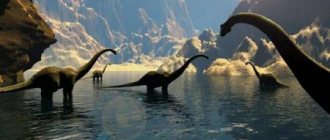Project for senior preschool children: “In the world of dinosaurs”
By number of participants: individual
Duration: short-term (two weeks).
Materials
: scientific and fiction literature, encyclopedia, images of various types of dinosaurs, films and cartoons about the life of dinosaurs, (electronic resources), salt dough, gouache paints, brushes, colored pencils, album sheets, colored paper, glue, scissors, coloring books with dinosaurs and etc.
Expected results:
Introducing the child to representatives of the most ancient fauna on Earth - dinosaurs, their species, features, in order to show the diversity of the animal world; its continuity;
arouse interest in the child and instill a taste for the simplest forms of research and scientific work based on the project material.
Project technology
:
Project stages
: preparatory, main, final.
Preparatory stage.
During the implementation of the preparatory stage, the problem, goals and objectives of the project were formulated. The material and equipment for the work have been selected. A conversation was held with the child “What do we know about dinosaurs?” A work plan has been drawn up. To attract parents to the project, the teacher held a consultation for them: “How to help a child learn about the era of dinosaurs?”
Implementation plan for the preparatory stage of the project.
Events or main activities
| Deadlines | Participants | Events | Responsible |
| 01.10.2018 | Teacher, parents | Consultation for parents “How to help children learn about the era of dinosaurs?” | Teacher Pokhomova I.V. |
| 02.10.2018 | Teacher, child | Conversation with a child “What do we know about dinosaurs?” | Teacher Pokhomova I.V. |
| 03.10.2018 | Teacher, child, parents | Preparation of information material and drawing up a work plan | Teacher Pokhomova I.V., parents |
Main stage:
During the implementation of the main stage, a story was read and a conversation was held based on illustrations and photographs «
Who are dinosaurs and when did they live?
" (Appendix No. 1),
conducted a didactic game "Journey to Dinosaurs"
(Appendix No. 2)
, watched the film "Scientists have found facts about the existence of dinosaurs", as well as the cartoons "Ice Age", "Dinosaur", "The Land Before Time" . During this work, the child became acquainted with the existence of dinosaurs, their structure and way of life, the types and types of dinosaurs, how they differed from each other, and why they became extinct.
It was decided to create a “Dinosaur World” model. The basis for the vegetation of the model was a flower pot filled with soil, artificial greenery, dead wood, samples of various types of stones, sand, which reflects the flora of the Jurassic period, the heyday of dinosaurs. Together with the parents, figurines of dinosaurs, representatives of that period, were also collected. Also, a proposal was received from the child and parents to select coloring books from the cartoon “Ice Age” and create a large folder of “Dinosaurs” coloring books. Parents also took an active part in the implementation of the project; together with their child, they looked at and talked about the encyclopedia “Everything about Dinosaurs” at home, and selected poems and stories about dinosaurs to create the book “The Age of Dinosaurs.” Also, a memo “Tell your children about dinosaurs” was developed for parents and a laptop book was created for children of the younger group “Dinosaurs for Little Ones” (Appendix No. 3)
.
Looking for Dinosaurs
Used Books.
1. “Dinosaurs and other extinct animals”, publishing house “Makhaon” 2005.
2. L. Watts, “Prehistoric Life”, Moscow, “Rosman” 1999.
3. I. Yakovleva, “Trace of the Dinosaur”, Moscow, “Rosman” 1997.
4. M. Avdonina, “Dinosaurs”. Complete encyclopedia, Moscow, Eksmo, 2007.
5. “All about dinosaurs”, publishing house “Astrel”, Moscow, 2000.
6. L. Cambournac, “Dinosaurs”. Children's Encyclopedia, Moscow, "Swallowtail", 2006.
Appendix No. 1
Memo for parents “Tell your children about dinosaurs”
Everything secret and mysterious always attracts children. The thirst for knowledge can be satisfied during search and research activities. We invite you to expand your children's understanding of dinosaurs - the most ancient animals on our planet. Of course, it is difficult for a child to remember all the names of dinosaurs, but it will be very interesting for him to hear the unusual names of these representatives of the fauna. We will need cardboard, colored paper, a CD, glue, double-sided tape and imagination.
1. On a landscape sheet, draw a sketch of the panel.
2. Transfer the details onto a sheet of colored paper. To do this, attach the sketch and colored paper to the glass and trace the parts of the dinosaur's body.
3. Cut out the outlined parts. A child can do this too.
4. Glue the cut-out parts onto paper of a contrasting color, add decoration (eyes, spots, webbed feet) and cut out, leaving a 2-3 mm border of contrasting paper.
5. Trace the disk on a sheet of cardboard, calculating its location in accordance with the sketch. So that the remaining details do not go beyond the framework.
6. Glue the dinosaur body parts, slightly extending beyond the outline of the disc.
7. Glue pieces of double-sided tape onto the disk, peel off the protective film and connect it to the outline of the base.
8. Draw the eyes with a marker or felt-tip pen and stick on the surrounding objects. Here you can use fragments of postcards and illustrations from magazines. This is the kind of beauty we get.
Master class “Such funny dinosaurs.”
What can we tell children about dinosaurs? Dinosaurs lived a very long time ago, several million years ago, when there were no people on Earth yet. They can be compared to crocodiles, turtles and snakes. These are huge animals that lived both on land and in water. Among them were herbivores and predators. Dinosaurs lived in all parts of the world, their remains are still found and skeletons are collected so that people can see the owners of forests and fields who lived millions of years ago. Why did they go extinct? There is still no exact answer to this question. Some scientists believe that the Earth has become very cold. Other experts believe that solid objects fell from space, raising clouds of sand and dust, which led to a solar eclipse and climate change. Still others prove that dinosaurs were poisoned by plants. Accompany your stories by looking at books and encyclopedias. Search and research activities can also be carried out on the street. Pre-prepare the dinosaur body parts by cutting them out of linoleum or plywood. Place them in a sandbox, sprinkled with sand. Tell your child that it is possible that there are dinosaur remains in your sandbox, and carefully try to “find” them using brushes and spatulas. Having found all the parts of the body, invite your child to assemble a model of a dinosaur and draw it at home or sculpt it from plasticine. Dinosaurs can be called “TV stars.” Many films are being made about the times of the Jurassic and Cretaceous periods, chilling the blood. Try to watch such films without children. Invite your preschooler to watch the animated series “Dinosaur Train.” Read fairy tales about dinosaurs: “The Tale of a Dinosaur named Clueless,” “The Tale of the Flying Dinosaur,” “The Tale of the Dinosaur Brothers.” Reinforce the knowledge gained by going to the zoo or creating dinosaurs with your own hands. You can make a notepad. From paper folded like an accordion, cut out the silhouette of a dinosaur your child likes. Staple the sheets of paper. Not only the child, but also his friends will like such a souvenir.
MAGAZINE Preschooler.RF
Project for the preparatory group “Collection-dinosaurs”Project passport: Teachers: Nemirova Y.K., Guzhova I.V.
Project theme: collection of our group “Dinosaurs” .
Relevance of the project:
The modernization of preschool education has led to the search for new forms of organizing education in kindergarten, since the education of preschoolers has its own characteristics. The main result of modern education is not what the child has learned, but how much it has contributed to his development and the formation of integrative personality traits.
For the formation of cognitive activity of preschoolers, such an area as collecting is of interest.
Collecting is invaluable for the development of preschoolers. The task of adults is not only to captivate the child with the idea of creating a collection, but also to help him in every possible way in this. Since the benefits of this type of activity are undeniable and invaluable:
- Cognitive and research activity is one of the natural areas of activity clearly demonstrated by preschoolers. Children have a natural urge to collect, or more precisely, to search. In the process of collecting, the process of accumulating knowledge first occurs, then the information received is systematized and a readiness to understand the world around us is formed. Items from the collections add originality to gaming, speech and artistic creativity and activate existing ideas.
- In the process of collecting, attention, memory, thinking, the ability to observe, compare, analyze, generalize, highlight the main thing, and combine are developed. Collecting broadens children's horizons, develops their cognitive activity, and develops the child's abilities, which are steps to creativity.
- Many problems in establishing relationships with children can be overcome if you find a common cause that allows you to combine the interests of the child and the adult. This is relevant when there are children in the group with uneven behavior, motor-active, anxious, uncommunicative and shy.
- Collecting decorates our lives, makes it fuller and more varied.
In our group we created a collection of dinosaurs.
Paleontologists have long debated when dinosaurs lived and died out. This topic is especially interesting for our little people – children. When did dinosaurs live and why did they disappear - questions that children often ask. And they need to try to give the most truthful and understandable information to them. After all, there is still no clear answer about the reason for the extinction of dinosaurs.
One day Gleb brought a new toy to kindergarten. It was a big dinosaur. The guys were very interested in this unusual animal. Children asked a lot of questions about when dinosaurs lived, what they ate, and how they reproduced. In this connection, it became clear that the topic of prehistoric inhabitants of the planet is of interest to the children of our group. And we decided to find out everything about dinosaurs, the time when they lived, and, of course, the reasons for the extinction of dinosaurs. Suddenly, knowing these reasons, it is possible to prevent the extinction of other animals in the future. In addition, the relevance of the topic is that this is the past of our planet, and in order to look into the future, we need to know our past.
The goal of the project is to develop cognitive and research activities in preschool children through collecting.
Project objectives:
- introduce the amazing animals of the past - dinosaurs, the variety of dinosaur species and their external features;
- develop cognitive processes: speech, memory, thinking, imagination, attention, coherence;
- continue to develop cognitive skills: observation, ability to compare, classify, group and generalize, draw conclusions;
- cultivate a sense of caring attitude towards living nature;
- to involve parents in the implementation of joint child-adult activities, to create an atmosphere of community of interests for the development and upbringing of children.
The duration of the project is short-term, 2 weeks.
Place of implementation - MDOU "Kindergarten No. 113" .
The participants of the project are teachers, children, parents.
Implementation stages:
- preparatory:
- collection and processing of information;
- conversations - “Who are dinosaurs?” , “What did dinosaurs eat?” , “How did dinosaurs take care of their offspring?” , “Are there animals similar to dinosaurs?” , “How do we know about dinosaurs” ;
- watching cartoons “Ice Age” , “Dinosaur” , “The Land Before Time” ;
- exhibition and reading of a collection of books about dinosaurs;
- reading the encyclopedia “How life appeared on Earth” , “The World of Dinosaurs” ,
- selection of illustrations;
- dinosaur coloring pages;
- modeling dinosaurs from plasticine;
- selection of toy dinosaurs;
- viewing a presentation for children “Who are dinosaurs” .
- basic
- production of a three-dimensional model of “Dinopark” ;
- making your own hand-made book “The World of Dinosaurs” ;
- presentation of the “Dinosaurs” for children of other groups;
- musical entertainment "Onega Collections" .
- final
- a presentation of the layout was made for children of other groups and parents;
- the design of the man-made album “The World of Dinosaurs” ;
- A final discussion about dinosaurs was held.
Conclusion
The use of collecting technology in the educational process expands the teacher’s capabilities in organizing interesting and educational activities with children. The substantive basis of collecting coincides with the child’s cognitive interests.
In the process of collecting, children formed ideas about the objects of the surrounding world on the topic of collections; showed activity, initiative, developed creative abilities in various types of children's activities; parents became active in the educational process (in the creation and presentation of children’s collections); The level of parents' satisfaction with the organization of the educational process has increased.
| Next > |




